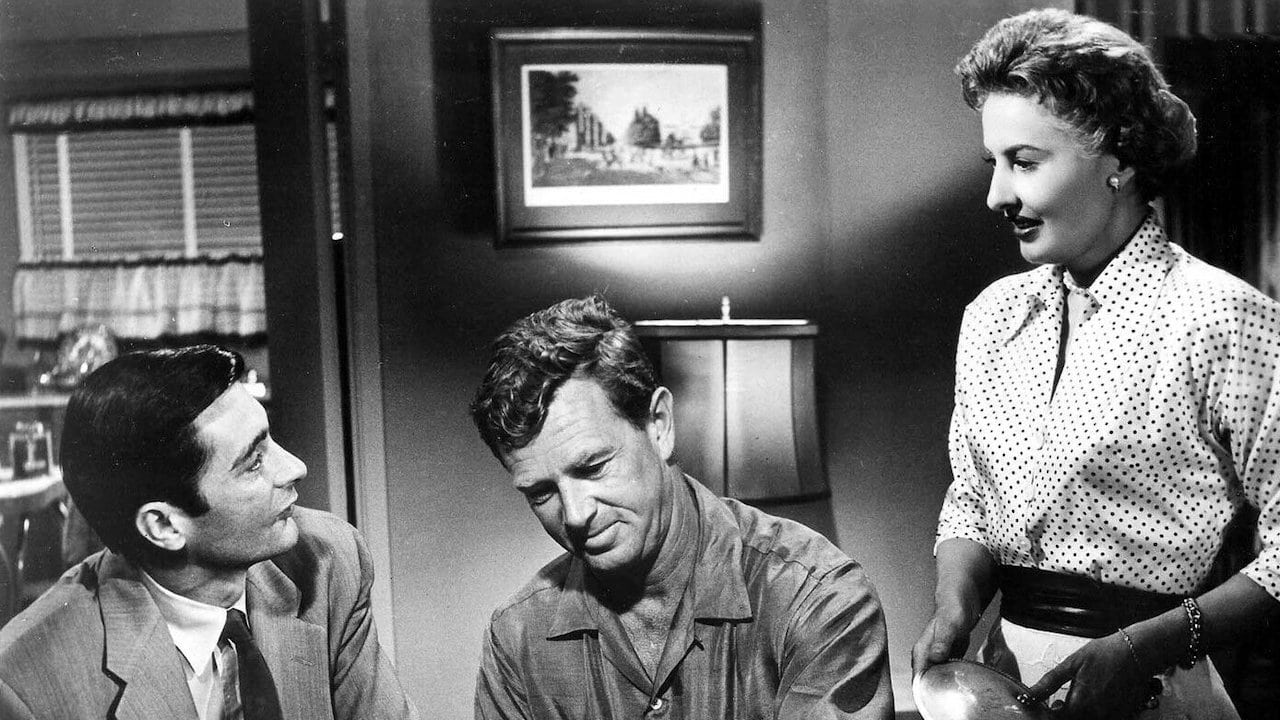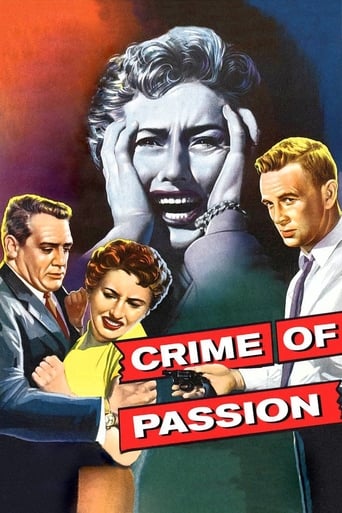

I say, '3 decades too late', because this film catches the early wave of the 'feminist' movement (lots of protest about a woman quitting her great job to become a housewife), but missed the free thinking from 1930-34, before the Hayes code was strictly enforced. Example: the code dictated (among other things) a criminal could not profit from a crime; a wife could be unfaithful, but had to end up unhappily if so; the word 'sex' or 'pregnant' were unmentionable, etc. etc.So, we have Barb Stanwyck, herself the protagonist of several pre-code films, some of semi-seamy variety, giving up a great career as a renowned true crime-scandal journalist, to marry Sterling Hayden, a non-ambitious police detective. I broke up laughing when Barb hosts a party of officers and the wives: the guys play poker in one room, the women drive Stanwyck crazy prattling on & on about recipes.Anyway, someone betrays someone and gets shot for it. In the pre-code era, the scriptwriter might have concocted a rationale to allow the shooter to go undetected - possibly revealing the deceased as a real scoundrel who got what he reserved. But in the mid-50's, with the Code firmly in place, convention called for a predictable wrap-up. Yeah, yeah, justice prevails - sadly. Give me TCM's vault of pre-code films any day - I was surprised to learn that the demographic to whom these hard-edged films appealed was--- (wait for it) - married women in their early 30's!!! (I always wondered where the 'lib' movement started).So, it's a movie that's very early 'feminist', but too late for the 'pre-code', that might have dealt more open-handedly with the outcome.
... View MoreFeisty newspaper columnist Kathy falls for LA cop Doyle and marries him. Trouble is she bridles at dull suburban life and his complaisant attitude. Thus she begins scheming to raise his place in the detective bureau, leading to unforeseen consequences.As a crime drama the movie never really gels. There's no tension, while the only suspense comes at the end. As a vehicle for aging diva Stanwyck, she's a bit over-age for the irresistible wife and other-woman parts. The romantic scenes try hard but are none too persuasive.Where the movie succeeds is in its iconoclastic view of 1950's middle-class conformity. At a time when movies and TV were saturated with images of suburban bliss, a sub-plot here dares suggesting gender role-playing in the suburbs can be emptying. The housewives silly conversations (everything's "wonderful") are spread on pretty thick, still we get the idea. At this point, it becomes a stretch to see the dynamic Kathy (Stanwyck) stay with a boring marriage since we know she has a real independent streak.Fortunately, director Oswald manages the erratic material in smooth fashion. He's definitely an underrated helmsman from that period, as his half-masterpiece A Kiss Before Dying (1956) demonstrates. Catch some of his good touches such as the lit candle fadeout punctuating Kathy and Doyle's kindled attraction. Hayden too, is coming off an iconic role as the gang leader in Kubrick's breakthrough caper film The Killing (1956). As a cop here, the towering Hayden's excellent, but as Stanwyck's devoted husband and lover, he strikes me as miscast.Overall, the film's too erratic to register as anything more than a time-passer. But it is good to note that Stanwyck soon adjusted to more appropriate matriarchal roles than that of a middle-age temptress.
... View MoreMistitled, the Crime here is not one of Passion but of other Things. Frustration Mostly, an Inability to Escape the Confines of Conservatism and a Predetermined Place that Society has Set Up for a Woman in Postwar America. Barbara Stanwyck is a Thoroughbred asked to drive a Buggy. It is this Predicament that the Film Exploits but while it is an Edgy and Topical Story for the Late Fifties, the Execution and Exposition is None too Smooth. A Good Cast tries Nobly to make it all Say Something Worthy, it is just too Thin a Story and Most of it is Forced into its Many Turns as Stanwyck comes Unglued.The Abruptions that the Movie takes from the Beginning are Stark and Strain Credulity. There are some Unintentionally Funny Moments (darning socks) and some of the Melodrama is Murky and the Result is a Somewhat Haphazard Film with a Good Story to Tell and some Sociological Comments to Make, but it isn't Told Very Well and the Statements are more Thrown Out There than Realized.Overall it is a Mediocre Attempt at a Very Interesting Take on a Situation that Needed some Exploration and Examining. The Housewife's Plight and a Women's Place in the Man's World of the 1950's was a Target Worth Shooting Towards. This One Came Close to the Mark but Missed.
... View MoreCRIME OF PASSION - never mind the generic title - exhibits much that's recommendable, but never quite jells as it might have under more imaginative direction and, much as I hate to fault powerhouse performers such as Stanwyck and Hayden, with different casting.What we have here is really a sort of suburban "All About Eve:" the portrait of a manipulative schemer who'll stop at nothing in service to ambition, even when that ambition is to be simply the dutiful woman behind the successful man. Another reviewer aptly calls the film "subversive," and this element could have provided its most interesting facets had it been more fully explored. By the mid-to-late 50's, some films were taking a hard-edged second look at the established conventions and revered institutions of postwar American life, and while this one appears at times to aspire to a similar examination - in this case, of the potentially stifling nature of traditional gender roles - it trips itself up in execution, leaning to heavy-handedness when subtlety is called for, and ultimately surrendering to a too-conventional presentation of a "woman at the breaking point" theme that was such a staple of players like Joan Crawford - and Stanwyck herself - during this period.The been-around-the-block maturity of Stanwyck at this stage of her career is squeezed into a rather tight fit: that of a career woman who, on the brink of long hoped-for advancement, sacrifices all for love and transfers her personal ambition to the professional betterment of her new husband. Likewise, Hayden's normally brusque and self-assured persona seems uncomfortably constrained in the role of a pedantic police professional who cares little for departmental politics and career success, and is more comfortable with a solicitous passivity toward both his working and personal relationships.One casting bulls-eye is scored with Raymond Burr as the departmental chief who misses nothing, and immediately spots - and appreciates - Stanwyck for the kind of woman she is. As a sort of counterpart to "Eve's" Addison DeWitt, Burr silkily embodies both graciousness and menace, and his sly underplaying projects true power not only of character but of performer, easily dominating every scene in which he appears. With this approach, he seems the only cast member with a handle on what a rich film CRIME OF PASSION could have been.If undemanding, it's diverting enough, and would certainly be worth seeing for Burr's multi-dimensional work alone, but it's also worth pondering, while one watches, the fascinating possibilities at which it all too briefly hints.
... View More